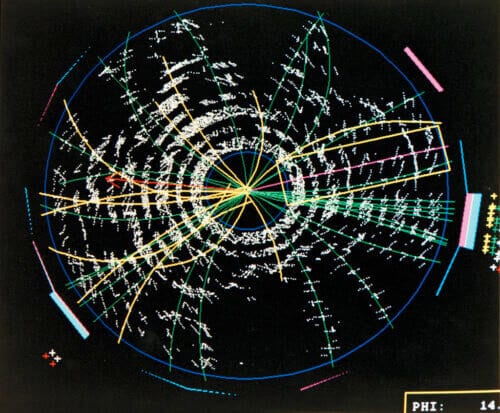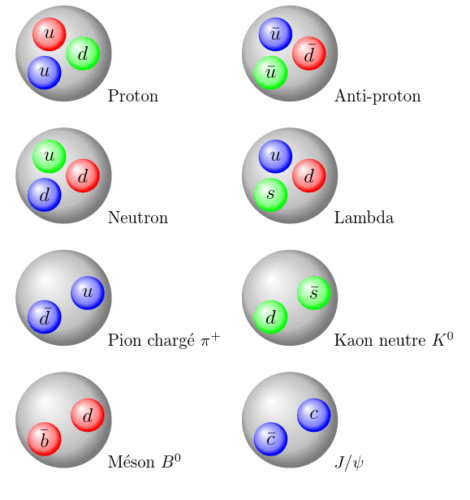The European Organization for Nuclear Research (CERN) has announced that the Large Hadron Collider has discovered four new particles, but what has changed? Since the accelerator was first activated in 2009, 59 new particles have been discovered, including the famous Higgs boson that was discovered in 2012. Although most of the new particles were discovered in accordance with expectations, some of them were particularly surprising

The ultimate goal of the axis accelerator is to study physics at extremely short distances. The accelerator is capable of concentrating a high amount of energy to study the standard model, the model that incorporates the laws of nature of all forces and particles of matter. One of the famous successes of the accelerator is of course the discovery of the Higgs boson which gives the particles of matter their valve under the mechanism of "spontaneous breaking of symmetry". With all the successes, there are still many question marks.
One of the famous riddles (also among mathematicians) is the "confinement riddle" which stems from the strong force, the force that binds the particles of matter that create the hadrons in nature. To understand the "imprisonment riddle" we will first explain what hadrons are and what they are made of. The basic Heggadah for a hadron is a particle made up of quarks. Six quarks have been discovered in nature, characterized on the basis of valence and the electric charge they carry. For the most part, the heavy quarks are very rare and therefore nature abounds mainly in light quarks - "up" and "down". Those quarks build the nuclear particles in the atom, i.e. the protons and neutrons, these belong to a sub-class in the hadron family called "baryons". The baryon consists of three quarks that are glued together with the help of the strong force mediated by the gluon (a force-carrying particle similar to a photon). For example, the proton consists of two up quarks and one down quark. The complex structure of nature's particles leads physicists to ask how gluons infect quarks in a three-dimensional world? This question is known as the "confinement puzzle" because it refers to the confinement of quarks by means of the gluons (or the strong force). Don't get me wrong, a computer can show this quite clearly, but we don't have the mathematical tools to prove that confinement does exist.

Confinement of quarks
The confinement actually comes from the opposite behavior of the strong force unlike the other elementary forces in nature. Unlike the electromagnetic force, the strong force intensifies as the particles move away from each other. We all know such a force from everyday life, a spring or a rubber band is an excellent example of this. The force exerted by the spring increases as the spring stretches or contracts. Despite the differences, the tangent lines between the electric force and the strong force cannot be ignored. We all know that opposite electric charges attract each other and like charges repel each other. The dynamics between the charges can create local areas without charge, just like the atom. Similar to the electric force, the strong force attracts quarks towards each other so that the "color" charge is reset. Color has no physical meaning, but it makes sense. When quarks were discovered, physicists noticed that they appeared in triplets. In optics, it is known that the blue, red and green light together create the appearance of white light. Apparently the triple "cancelled" the color of the light. In analogy to light, the charge in relation to the strong force is "red", "blue" and "green". To reset the strong charge, the gluons tend to combine quark triplets. As a result, the resulting hadron has a "white" charge, meaning it has no charge in relation to the strong force.
Next to the baryons, there are the "mesons" consisting of quarks and antiquarks. The anti-quark has a similar mass to its quark counterpart but has opposite electric and strong charges (the color red, for example, has an anti-red charge that together complement white). Therefore, the food also lacks a strong charge. If we could pull a quark out of the hadron, the energy expended to remove it would be large enough to excite the quark fields and create a quark and an antiquark from the vacuum. The quark created from the tearing process would combine with the hadron and the antiquark would combine with the extracted quark to form food.

New "magical" particles
When quarks were first discovered, physicists realized that there were only a handful of possible combinations in nature - mesons (a quark and an antiquark), baryons (three quarks), antibaryons (a trio of antiquarks), a tetraquark (two quarks and two antiquarks) and a pentaquark (a quartet of quarks and an antiquark). one). The in-depth reader must have noticed that the rule for physical integration is that the number of quarks minus the number of antiquarks must be a multiple of three (or simply zero). Physicists treated most of them as theoretical combinations, and in practice the hadrons simulated in accelerators were only baryons and mesons.
Only recently in 2003 Discovered in Japan Particles that are not nutrients or baryons. The Japanese researchers summarized the results of the study by claiming that the particles discovered are tetraquarks. The other significant discovery came in 2015 when the Besarn accelerator announced the Discovery of two pentaquarks. Now, the four particles recently discovered They are tetraquarks consisting, among other things, of a pair of "magic" quarks.
If you add up the number of particles discovered in the axle, you get 59 particles. These include, among others, the new tetraquarks, but of course also mesons and baryons that were discovered thanks to the hadron accelerator. Hadrons are fascinating particles to study because they reveal how nature binds quarks together. Reviewing the hadrons created in the accelerator can tell physicists which hadrons nature "favors" less, i.e. which hadrons are not easily created and why. Another question that often comes up is why almost all tetraquarks have at least one magic quark? A satisfactory explanation has not yet been found for this. The researchers at Sarn are also curious to understand whether the heavier and rarer hadrons are bound as one piece like baryons and mesons or whether the bond between the quarks is loose, similar to molecules in nature.
These and other questions help scientists around the world understand the nature of the strong force and thus complete the puzzle towards the "Torah of Everything", one that can in the future describe all the forces in nature on every energy scale.
More of the topic in Hayadan:
- Forget neutron stars, quark stars may be the most dense objects in the universe
- Summary of the year 2008 in science was marked by the particle accelerator
- A "magical" pentaquark particle may be discovered
- New information from the Axial Accelerator may shed light on the antimatter puzzle in the universe
- Quarks, bosons and gluons - the standard model on the edge of the fork

7 תגובות
The answer to the riddle is natural selection, which is a law that also includes man, and therefore man will never be able to understand it, like a tomato trying to understand that it is a tomato and what that means, it will never succeed.
A free man - absolutely not. Most of the progress of particle physics was in the second half of the twentieth century (after Einstein and Bohr had already passed away), and the particle accelerators built then played a large part in this progress.
Because the dominant theory is wrong. Similar to Ptolemy's structure of the universe. The scientists became cardinals. And they refuse to admit what is obvious to the eye "because it is clear that you are wrong even if I don't know what your mistake is".
Thanks for the article, great explanation. Reminds me of the second book of the three-body problem, whoever hasn't read it, now is the time.
1
There will be no end to the discovery of particles. The more you bombard particles you once discovered with higher energies, the more they will split into more particles. The process is infinitesimal. The reason is that matter is something that we perceive with our senses and with our measuring devices which are the long arm of our senses because in the end everything translates into data that one of our senses perceives and gives it meaning and in this case we call it particles or matter and it seems tangible to us and rightly so. But matter is actually energy in different densities and nothing else.
Full gas in neutral is what they do there. Burning billions on a cosmic butterfly net of size zero.
Physics has not progressed at all in the last hundred years. All these boosters did not advance the Torah. We've pretty much been in the same place since Einstein and Bohr. You have to throw away these boosters and start thinking about what to do, because science isn't going anywhere.